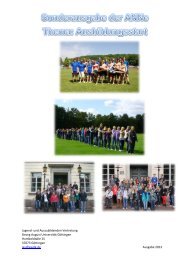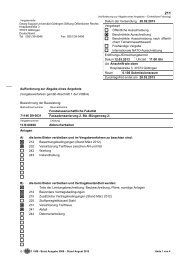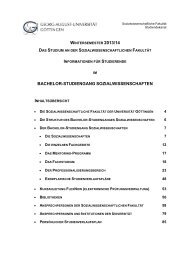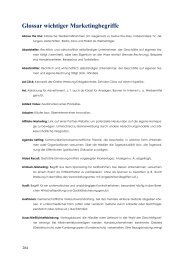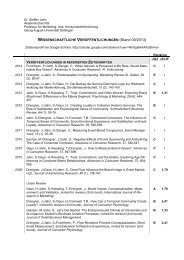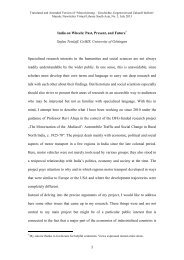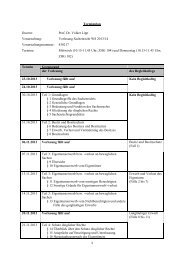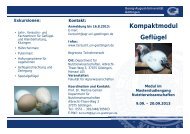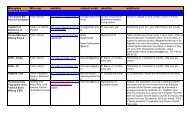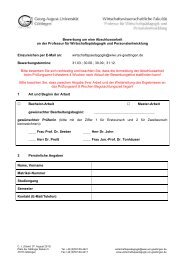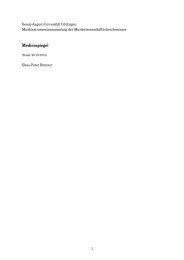CRC 990 - EFForTS - Georg-August-Universität Göttingen
CRC 990 - EFForTS - Georg-August-Universität Göttingen
CRC 990 - EFForTS - Georg-August-Universität Göttingen
You also want an ePaper? Increase the reach of your titles
YUMPU automatically turns print PDFs into web optimized ePapers that Google loves.
<strong>CRC</strong> <strong>990</strong> Ecological and Socioeconomic Functions of Tropical Lowland Rainforest Transformation Systems (Sumatra, Indonesia) Issue 1 / <strong>August</strong> 2013<br />
page 14 von 32<br />
B11<br />
II. Integration of Ecological and<br />
Socioeconomic Research<br />
Integration / integrative research activities across<br />
disciplines in the <strong>CRC</strong> is realized through<br />
- the establishment of a joint enrichment<br />
planting experiment (B11)<br />
- four thematic foci / overarching joint hypotheses.<br />
Title: Biodiversity enrichment in oil palm plantations:<br />
ecological and socio-economic impacts<br />
Team: Holger Kreft, Ulrich Brose, Dirk Hoelscher, Yann<br />
Clough, Meike Wollni (UGoe), Hendrayanto, Leti<br />
Sundawati, Prijanto Pamoengkas (IPB), Bambang<br />
Irawan, Rosyani (UNJA), Aiyen (UNTAD),<br />
Miriam Teuscher, Anne Gérard (PhD students)<br />
Aims: Increasing the biodiversity within an oil palm<br />
plantation by planting trees inside gaps. The<br />
objective of the experiment is to find out how<br />
enrichment planting with different diversity levels<br />
of one, two, three and six tree species affects<br />
ecosystem functioning, plant and animal diversity<br />
and the productivity of oil palms. The main<br />
questions to be addressed are:<br />
Can biodiversity and associated ecosystem services<br />
- (biological pest control, enhanced pollination)<br />
be restored by enrichment planting?<br />
- Under which planting strategies do enhanced<br />
ecosystem services positively affect oil palm<br />
economics?<br />
Current status:<br />
Figure 1. Location<br />
of the experimental<br />
plots on the plantation<br />
of Humusindo<br />
(black dots). The total<br />
size of the experimental<br />
area (shaded)<br />
is ca. 140 ha.<br />
In October this year, plots of varying sizes will be<br />
established on an oil palm plantation (500 ha)<br />
owned by PT Humusindo, a company which is<br />
located near Bungku in the Batanghari region<br />
(Fig. 1). The plots will be systematically distributed<br />
within an oil palm plantation;<br />
diversity levels and the four<br />
different plot sizes will be randomly<br />
distributed (Fig 2).<br />
Figure 2. Experimental design at PT Humusindo A second B11<br />
experiment, varying forest distances and plot sizes, is planned at<br />
another location close to Jangga Baru, a village in the Batanghari<br />
region. The proposed plantation is intensively managed, ca. 4000<br />
ha big and of medium age. Adjacent to the northern border of<br />
the plantation there is a small protected forest.<br />
Preliminary study by Miriam Vorlaufer (C08) and<br />
Miriam Teuscher (B11):<br />
Title: How much is a bird? Bird diversity in smallholder<br />
oil palm plantations<br />
As a preliminary study of the B11 project we investigate<br />
the effect of enrichment plantings in smallholder oil<br />
palm plantations on bird diversity by combining economic<br />
with ecological data.<br />
www.uni-goettingen.de/de/310995.html • crc<strong>990</strong>@gwdg.de • Telephone: +49 551 39-1 21 18<br />
JFB Institute for Zoology & Anthropology • Berliner Strasse 28 • D-37073 <strong>Göttingen</strong>




